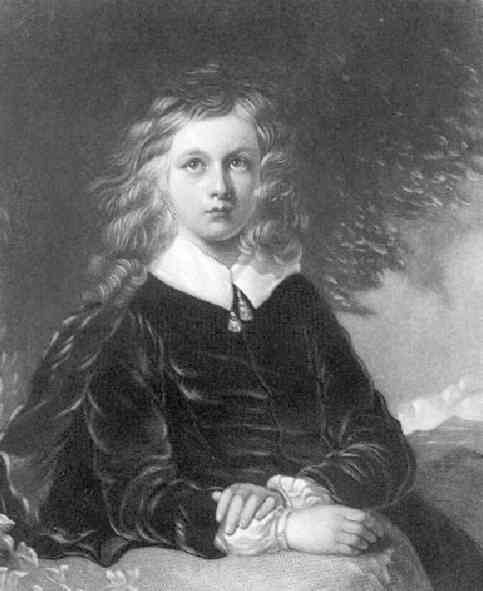
Figure 1.--This print was engraved by F.E. Jones from a drawing by F. Newanham. I'm not sure when the original drawing was executed. It depicts Milton at 12 years of age.


Figure 1.--This print was engraved by F.E. Jones from a drawing by F. Newanham. I'm not sure when the original drawing was executed. It depicts Milton at 12 years of age. |
John Milton, the author of Paradise Lost is consiered by many to be the greatest poet of the
17th century. He is note for his powerful, rhetoric prose and the eloquence of his poetry. Milton also wrote pamphlets
defending civil and religious rights. Milton was raised in a wealthy family and received an extensive educatiin. His family's wealth
accorded him the opportunity to devote himself to witing.
This portrait was published in an American literary and arts publication in 1856.
The original drawing was by F. Newanham. It was engraved by F.E. Jones.
John's mother was Sarah Jeffrey, the daughter of a merchant sailor. His father had risen to prosperity as a scrivener or law writer--he also composed music.
John Milton was born in London. HBC knows little about his boyhood, except that his family was wealthy. The family was wealthy enough to afford a second house in the country.
HBC has little information on this bouhood clothes. One later drawing show him in an elegant jacket and long hair.
John was educated at St Paul's School and then at Christ's College, Cambridge (1625-32)Hev was not very popular with the other boys. He was called, half in scorn, "The Lady of Christ's." During his Cambridge period, while considering himself
destined for the ministry, he began to write poetry in Latin, Italian, and English. The College authorities expelled John for a term after starting a fist fight with his tutor.
Milton, after leaving Cambridge, gave up his original plan to become a priest. He did not take up a profession, but instead spent 6 years at leisure in his father's home, writing during that time L'ALLEGRO, IL PENSEROSO (1632), COMUS (1634), and LYCIDAS (1637).
In 1635 the Miltons moved to Horton, Buckinghamshire, where John pursued his studies in Greek, Latin, and Italian. He traveled in France and Italy in the late 1630s, meeting in Paris the jurist and
theologian Hugo Grotius and the astronomer Galileo Galilei in Florence - there are references to Galileo's telescope in Paradise Lost. His conversation with the blind scientist Milton recorded in AREOPAGITICA, which attacked censorship.
Milton returned to London in 1639, and set up a school with his nephews and a few others as pupils.
The Civil War silenced his poetic work for 20 years. War divided the country as Oliver Cromwell fought against the king, Charles I. Concerned with the Puritan cause, Milton wrote a series of pamphlets against episcopacy (1642), on divorce (1643), in defense of the liberty of the press (1644), and in support of the regicides (1649). He also served as the secretary for foreign languages in Cromwell's government. After the death of Charles I, Milton published THE TENURE OF KINGS AND MAGISTRATES (1649) supporting the view that the people had the right to depose and punish tyrants.
In 1651 Milton became blind, but like Jorge Luis Borges is our century, blindness helped to stimulate his verbal richness. "He sacrificed his sight, and then he remembered his first desire, that of geing a poet," Borges wrote in one of his lectures. After the Restoration of Charles II in 1660, he was arrested as a
noted defender of the Commonwealth, but was soon released. Besides public
burning of EIKONKLASTES and the first DEFENSIO in Paris and Toulouse,
Milton escaped from more punishment after Restoration, but he became a
relatively poor man. In the 1660s Milton moved with his third wife to what is
now Burnhill Row. He spent there the remaining years of his life, apart from a
brief visit to Chalfont St Giles in 1665, to avoid the plague. His late poems
were dictated to his daughter, nephews, friends, disciples, and paid
amanuenses.
Milton married three times (Mary Powell, 1642; Katherine Woodcock,
1656; Elizabeth Minshull, 1662). His marriages were unhappy. Mary Powell grew bored with the life of a poet soon after the honeymoon was over and went back home where she stayed for 3 years. Milton wrote his famous essays on divorce. In THE DOCTRINE AND DISCIPLINE OF DIVORCE
(1643) Milton argued that a true marriage was of mind as well as of body, and that the chaste and modest were more likely to find themselves 'chained unnaturally together' in unsuitable unions than those who had in youth lived loosely and enjoyed more varied experience.
Though Milton was Puritan, morally austere and conscientious, some of his religious beliefs were unconventional to the point of heresy, and came into conflict with the official Puritan stand.
Navigate the Boys' Historical Clothing Biography pages:
[Return to Main biography page]
[Biographies A-F]
[Biographies G-L]
[Biographies M-R]
[Biographies S-Z]
Navigate the Boys' Historical Clothing Web Site:
[Introduction]
[Activities]
[Biographies]
[Chronology]
[Cloth and textiles]
[Clothing styles]
[Countries]
[Topics]
[Bibliographies]
[Contributions]
[FAQs]
[Glossaries]
[Satellite sites]
[Tools]
[Boys' Clothing Home]
